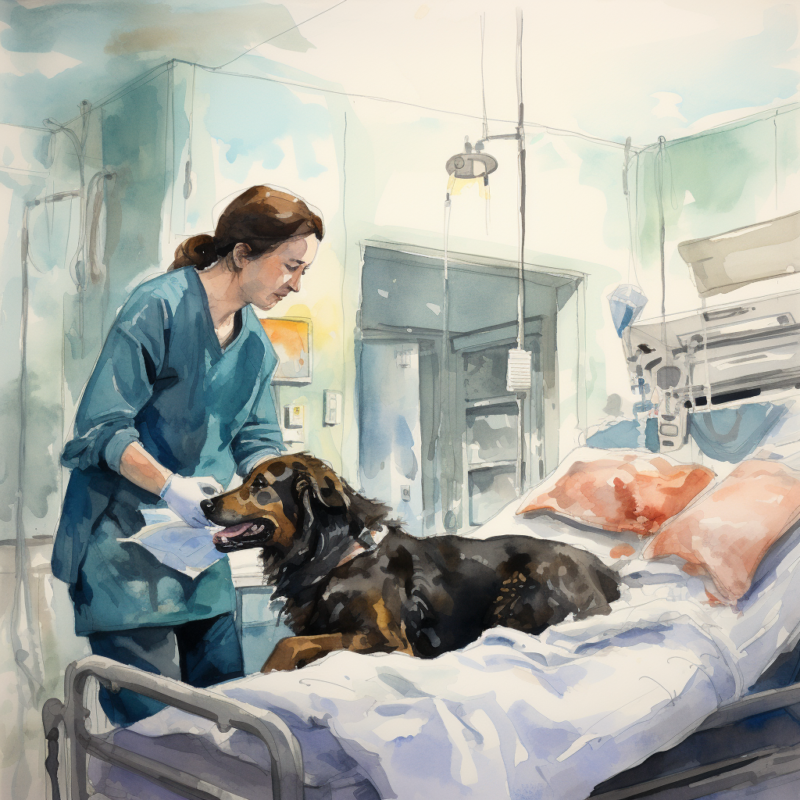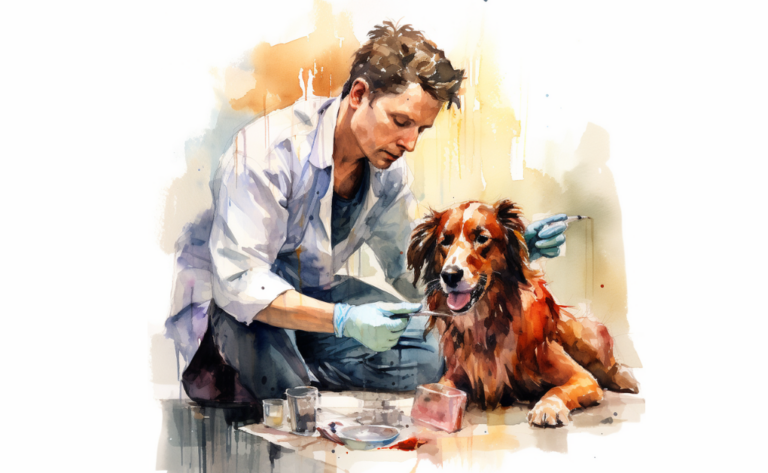What is Prostate Disease in Dogs?
What is it?
How is it Treated?
Breed Predispositions
Boxers Doberman Pinschers German Shepherds Golden Retrievers Labrador Retrievers Rottweilers Shih Tzus Siberian Huskies Standard Poodles Yorkshire Terriers
Introduction
It had been a few weeks since John noticed that his loyal German Shepherd, Zeus, was having difficulty urinating and seemed to be in pain. At first, he attributed it to the occasional upset stomach or a minor infection. However, as the symptoms persisted, John grew increasingly worried about his best friend’s health. He decided to schedule an appointment with the veterinarian to get to the bottom of the issue. After a thorough examination, the veterinarian informed John that Zeus was suffering from prostate disease, a condition that John had never heard of before.
Prostate disease in dogs is a prevalent condition affecting older male dogs, with about half of the intact male dogs experiencing prostate issues by the time they reach middle age. The prostate gland, located at the base of the bladder and surrounding the urethra, produces prostatic fluid that helps keep sperm healthy and strong. Unfortunately, many owners may not realize their dog has prostate cancer until after the dog’s passing. In addition, unneutered dogs are more likely to develop testicular cancer than neutered dogs.
Types of Prostate Disease in Dogs
There are four main types of prostate diseases in dogs:
Prostatitis
Prostatitis refers to inflammation of the prostate gland, which can be acute or chronic. It is often caused by bacterial infections resulting from urinary tract infections or other underlying health issues. Symptoms of prostatitis include fever, pain in the hindquarters, difficulty urinating, blood in the urine, and lethargy.
Benign Prostatic Hyperplasia (BPH)
BPH is dogs’ most common prostate disease, particularly in older, unneutered male dogs. It involves the non-cancerous enlargement of the prostate gland, which is often hormone-related. BPH can cause difficulty in urination and defecation, blood in the urine, and straining during bowel movements. It can also lead to urinary tract infections.
Prostate Cancer
Prostate cancer is less common in dogs than BPH but can be aggressive and life-threatening. Symptoms of prostate cancer may include difficulty urinating, blood in the urine, straining during bowel movements, weight loss, and lethargy. Unfortunately, by the time the cancer is detected, it may have already spread to other body parts.
Some breeds are more prone to developing prostate cancer than others. For example, German Shepherd Dog, Golden Retriever, Labrador Retriever, Boxer, Poodle, Doberman Pinscher, Rottweiler, Bull Terrier, Chow Chow, Cocker Spaniel, Dalmatian, English Springer Spaniel, French Bulldog, Great Dane, Irish Setter, Jack Russell Terrier, Keeshond, Maltese, Miniature Schnauzer, Pug, Shih Tzu, Standard Poodles, Yorkshire Terrier, and Vizsla are some of the most commonly affected breeds.
Prostatic Cysts
Prostatic cysts are fluid-filled sacs within the prostate gland. These cysts can vary in size and may cause symptoms like difficulty urinating, blood in the urine, and pain in the hindquarters. In some cases, prostatic cysts may become infected, leading to prostatitis.
When the prostate enlarges due to age or injury, dogs with prostate issues may experience urinary tract infections (UTIs), painful urination, and incontinence. In addition, the prostate is painful for the affected dog, and a prostatic cyst may develop. Prostate-specific arginine esterase, an enzyme involved in prostatic fluid production, may also be affected.
It is essential to monitor your dog’s health, mainly if they are an unneutered male or belongs to a breed predisposed to prostate issues. Regular check-ups with a veterinarian can help detect and address any problems early on, improving the quality of life for your canine companion.
What Causes Prostate Disease in Dogs
Various factors, including age, hormones, and infections, can cause prostate disease in dogs. The most common prostate diseases in dogs are benign prostatic hyperplasia (BPH), prostatitis, and prostate cancer. Here’s how each of these factors can contribute to prostate disease in dogs:
Inflammation of the Prostate Gland
Prostatic disease in dogs is primarily caused by inflammation of the prostate gland. This inflammation occurs when immune cells called macrophages infiltrate the prostate tissue and release chemicals that damage healthy cells. Damaged cells then attract other immune cells, leading to further harm to the prostate, such as prostatic infections. This type of inflammation is common in older male dogs and giant breeds.

Bacteria
The second most prevalent cause of prostatic disease in dogs is bacteria. Bacteria can enter through the urethra and cause an infection. Proteus Vulgaris is the most common type of bacteria responsible for prostate infections. Other bacteria contributing to prostate infections include P. aeruginosa, Klebsiella spp., Pasteurella multocida, Streptococcus mutans, and Escherichia coli.
Age and Hormones
As male dogs age, the levels of testosterone can cause the prostate gland to enlarge, leading to benign prostatic hyperplasia (BPH). BPH is a non-cancerous prostate gland enlargement that can cause discomfort, difficulty urinating, and other issues. Neutering can help prevent or reduce the symptoms of BPH, as it reduces testosterone levels.
Prostate Cancer
Prostate cancer is less common in dogs than BPH or prostatitis but can be a severe and aggressive disease. The exact cause of prostate cancer in dogs is poorly understood, but genetic factors, hormones, and environmental factors may contribute to its development. However, prostate cancer can cause symptoms similar to BPH and prostatitis, making it essential to consult a veterinarian for proper diagnosis and treatment.
Cysts and Abscesses
Fluid-filled cysts can form within the prostate gland, causing enlargement and discomfort. In addition, these cysts can sometimes become infected, leading to the formation of abscesses. Abscesses are pockets of pus within the prostate, which can be painful and potentially life-threatening if left untreated. Treatment for cysts and abscesses typically involves antibiotics and surgical intervention to drain the abscess and remove the infected tissue in severe cases.
Congenital Abnormalities
Some dogs may be born with structural abnormalities in the prostate gland, predisposing them to developing prostate disease. These congenital issues may include malformations, improper growth of the prostate, or blockages within the gland. Treatment for congenital abnormalities usually depends on the severity of the condition and may involve surgery to correct the issue.
Trauma
Physical injuries to the pelvic region can cause damage to the prostate gland, leading to inflammation, bleeding, and possible infection. Traumatic injuries may result from accidents, falls, or blunt force. Treatment for trauma-induced prostate issues will depend on the severity of the injury and may involve pain management, antibiotics, or surgery.
Immune-Mediated Disorders
In some cases, the dog’s immune system may mistakenly target the prostate gland, leading to inflammation and dysfunction. Immune-mediated disorders can be challenging to diagnose and treat, often requiring immunosuppressive medications to manage the condition.
Hormonal Imbalances
Conditions that cause hormonal imbalances, such as hypothyroidism or Cushing’s disease, can contribute to prostate disease in dogs. Hormonal imbalances can change the prostate gland’s structure and function, predisposing dogs to developing prostate problems. Treating the underlying hormonal condition can help alleviate the symptoms associated with prostate disease.
Symptoms of Canine Prostate Disease
The initial symptom of canine prostate disease is often a behavior change. A dog’s routine might suddenly appear unusual or even problematic. Prostate cancer is rare in dogs, but when present, it is typically malignant and can be fatal. For example, your dog may start barking at nothing, sleeping excessively, eating less than usual, or displaying aggression toward family members. They might also show an unusual interest in another animal (such as a cat) or spend excessive time playing alone.
Other symptoms of prostate disease in dogs can vary depending on the underlying cause and the severity of the condition. Common symptoms include:
- Blood in urine or semen
- Straining or difficulty urinating
- Frequent urination, often in small amounts
- Pain while urinating
- Constipation or difficulty passing stool
- Ribbon-like, thin stools
- Lethargy and weakness
- Pain or discomfort in the hindquarters or abdomen
- Stiff or abnormal gait
- Swelling in the abdominal area
- Fever (in cases of infection)
- Loss of appetite and weight loss
- Vomiting and diarrhea (less common)
Diagnosing Prostate Disease in Dogs
Prostate cancer is rare in dogs, but when present, it is typically malignant and can be fatal. Your vet may be able to determine whether your dog has a prostatic infection or cancer in the prostate through various diagnostic methods.
Physical Examination
The first step in diagnosing is to perform a physical examination. Evaluation of the prostate includes checking the size and shape of the testicles, looking for signs of an enlarged prostate gland or lymph nodes, examining the penis, assessing the anal glands, and palpating the prostate gland. If prostatic neoplasia or abnormalities are detected, further tests should be conducted.
Digital Rectal Exam
If the results from the physical exam revealed no abnormalities, the next step would be a digital rectal exam. This involves examining the prostate by inserting a gloved, lubricated finger into the dog’s rectum and pressing it around the prostate gland. The veterinarian will then recheck the gland.
Blood Test
A complete blood count (CBC) is a blood test that measures the number of white and red blood cells, hemoglobin, and platelets. It can also detect certain toxins in your dog’s bloodstream levels. This test is performed to check for any abnormalities or signs of illness.
Urinalysis
Urinalysis, typically conducted by a clinical toxicologist, can help identify the presence of drugs and other toxins in the urine. This test may also aid in diagnosing a prostatic abscess or infection.
Biopsy
A biopsy of the prostate tissue may be necessary to confirm the presence of cancer, which can be done using fine-needle aspiration. Another PSA test measures the Prostatic Specific Antigen (PSA) in the dog’s serum. High levels of PSA indicate prostate cancer, but low levels do not necessarily rule it out. Therefore, the veterinarian must consider several factors, such as the state of the urinary bladder, veterinary internal medicine history, and blood in the stool or semen, before making a final determination.
Treatment Options for Canine Prostate Disease
The treatment of prostate cancer in dogs is done through surgery, radiation therapy, chemotherapy, hormonal therapy, immunotherapy, targeted therapy, cryosurgery, laser therapy, brachytherapy, and watchful waiting.
Surgery
Each option has its benefits and drawbacks. For example, surgery is often recommended because it is less invasive than other treatments. However, it is expensive and requires anesthesia. In addition, it involves removing the entire gland from the body. This is usually done when no evidence of metastasis (spread) outside the gland exists. Therefore, surgery is often combined with hormone treatments.
Hormone Treatments
Hormone treatments include medications called luteinizing hormones or LHs, which stimulate testosterone production. These medications come in various forms, including injections, pills, and creams. Some men may also need surgery to remove their testicles and have a tube passed through the incision into the scrotum to inject the LHs.
Radiation Therapy
Radiation therapy uses X-rays to kill cells. This is one of the main methods used to treat prostate cancer. There are different types of radiotherapy: External beam radiotherapy and Intraoperative radiotherapy.
External beam radiotherapy uses energy directed at the tumor from outside the body. Intraoperative radiotherapy uses a particular machine during surgery to deliver radiation directly to the prostate gland.

Chemotherapy
Chemotherapy drugs are sometimes given before or after surgery. They can be taken orally or intravenously. Oral chemotherapy is given by mouth. Standard oral chemotherapies include doxorubicin, ifosfamide, and bleomycin. Oral chemotherapy can be taken with or without food. Intravenous chemotherapy is delivered through a vein into the bloodstream. Standard intravenous chemotherapies include vincristine, cisplatin, and etoposide. Intravenous chemotherapy can be taken with or without food.
Immunotherapy
Immunotherapy is another type of drug therapy. It works by stimulating the immune system to attack tumor cells. Monoclonal antibodies are injected into patients. They attach themselves to proteins on the surfaces of cancer cells. Other monoclonal antibodies target the receptors on cancer cells. A vaccine containing antigens found on prostate cancer cells is also used. Vaccination triggers the patient’s immune system to produce antibodies against the antigen.
Targeted Therapy
Targeted therapy is similar to chemotherapy except that it targets specific molecules on the surface of tumor cells. Antibodies bind to specific proteins on the surface of cancer cells—small molecules known as tyrosine kinase inhibitors block the action of enzymes involved in cell division. Tyrosine kinases are enzymes that transfer chemical groups onto other proteins.
Cryosurgery
Cryosurgery freezes the tissue around the tumor to destroy it. Laser therapy uses light waves to heat the area around the tumor. These treatments are very effective in the control of most types of cancer. However, there is always a small risk that the tumor will return.
Brachytherapy
Brachytherapy uses radioactive material placed directly into the tumor. It delivers radiation directly to the prostate via catheters inserted into the urethra.
Watchful waiting means doing nothing until symptoms appear. When your pet has an illness, it may need to be ready to wait. This means doing something once the symptoms appear. Watchful waiting is often used when it is unclear if a pet has an illness or is just emerging for the first time.
Other ways to treat Prostate cancer include interstitial implants, medication, and hormonal therapy.
Interstitial implants use needles to place radioactive seeds inside the prostate gland.
Drugs such as cisplatin, carboplatin, cyclophosphamide, etoposide, doxorubicin, gemcitabine, mitoxantrone, paclitaxel, docetaxel, topotecan, vincristine, vinorelbine, irinotecan, flutamide, leuprolide, goserelin acetate, bicalutamide, cyproterone acetate, estramustine phosphate sodium, diethylstilbestrol diphosphate, and prednisolone are used. Some of these drugs work by damaging DNA in cancer cells. Others block cell growth or stop them from dividing. Still, others prevent blood flow to tumors.
Hormonal therapy is another way to treat advanced prostate cancer. Medications like abiraterone acetate, enzalutamide, ketoconazole, letrozole, megestrol acetate, medroxyprogesterone acetate, nafarelin, nilutamide, octreotide acetate, oxandrolone, tamoxifen citrate, triptoreline, and zoledronic acid are used. Hormonal therapy blocks the effects of male sex hormones. They help reduce the amount of testosterone produced by the testicles. Testosterone stimulates prostate cancer cells to grow.
How to Prevent Prostate Disease in Dogs
Preventing prostate disease in dogs is essential to maintain your pet’s overall health. Although there are no guaranteed prevention methods, there are several measures you can take to reduce your dog’s risk of developing prostate disease.
- Neutering: Neutering male dogs, especially young dogs, can significantly reduce the risk of developing prostate disease, including benign prostatic hyperplasia (BPH) and prostatitis.
- Regular veterinary check-ups: Regular veterinarian visits can help detect prostate issues early, allowing prompt treatment and management. This is particularly important for older, unneutered male dogs at a higher risk of developing prostate problems.
- Monitoring for symptoms: Keep an eye on your dog’s behavior and monitor for any signs of prostate issues, such as difficulty urinating, bloody urine, or discomfort during defecation. If you notice any of these symptoms, consult your veterinarian.
- Maintain a healthy weight: Obesity can exacerbate specific prostate issues. Ensuring your dog maintains a healthy weight through proper diet and exercise can help reduce the risk of prostate disease.
- Prevent infections: In some cases, bacterial infections can cause prostatitis. To help prevent infections, maintain a clean environment for your dog, and ensure they have access to clean water.
- Good hygiene: Practice good hygiene for your dog, including regular grooming and cleaning of their living area, to help minimize the risk of infections that could lead to prostate issues.
- High-quality diet: Feeding your dog a balanced and high-quality diet will support overall health and well-being, which can contribute to a lower risk of prostate disease.
By following these preventive measures, pet owners can help reduce the risk of their dogs developing prostate disease. If you have concerns about your dog’s prostate health or notice any symptoms, consult your veterinarian for proper diagnosis and treatment.
Frequently Asked Questions
Disclaimer: The information provided on this veterinary website is intended for general educational purposes only and should not be considered as a substitute for professional veterinary advice, diagnosis, or treatment. Always consult a licensed veterinarian for any concerns or questions regarding the health and well-being of your pet. This website does not claim to cover every possible situation or provide exhaustive knowledge on the subjects presented. The owners and contributors of this website are not responsible for any harm or loss that may result from the use or misuse of the information provided herein.







